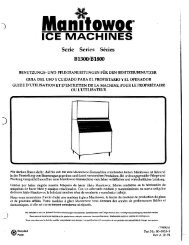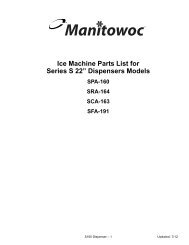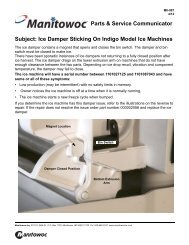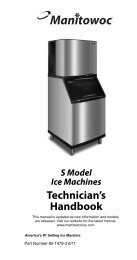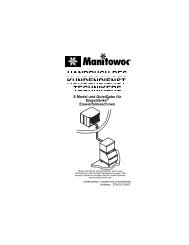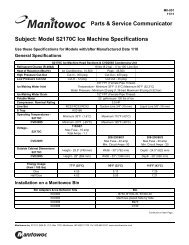S1800 Marine Model Ice Machines – Service Manual - Manitowoc Ice
S1800 Marine Model Ice Machines – Service Manual - Manitowoc Ice
S1800 Marine Model Ice Machines – Service Manual - Manitowoc Ice
You also want an ePaper? Increase the reach of your titles
YUMPU automatically turns print PDFs into web optimized ePapers that Google loves.
Section 7 Refrigeration System<br />
SAFETY LIMITS<br />
General<br />
In addition to standard safety controls, such as high<br />
pressure cut-out, the control board has two built in safety<br />
limit controls which protect the ice machine from major<br />
component failures.<br />
Safety Limit #1: If the freeze time reaches 60 minutes,<br />
the control board automatically initiates a harvest cycle.<br />
If 6 consecutive 60-minute freeze cycles occur, the ice<br />
machine stops.<br />
Safety Limit #2: If the harvest time reaches 3.5 minutes,<br />
the control board automatically returns the ice machine<br />
to the freeze cycle.<br />
If 500 consecutive 3.5 minute harvest cycles occur, the<br />
ice machine stops.<br />
Safety Limit Indication<br />
When a safety limit condition is exceeded:<br />
• Six consecutive cycles for safety limit 1 - the<br />
control board enters the limit into memory.<br />
• Three consecutive cycles for safety limit 2 - the<br />
control board enters the limit into memory and<br />
the ice machine continues to run.<br />
Use the following procedures to determine if the control<br />
board contains a safety limit indication.<br />
1. Move the toggle switch to OFF.<br />
2. Move the toggle switch back to ICE.<br />
3. Watch the safety limit lights (SL-1 and SL-2). If a<br />
safety limit has been recorded, either the SL-1 light<br />
will flash once or the SL-2 light will flash twice,<br />
corresponding to safety limit 1 or 2 to indicate which<br />
safety limit stopped the ice machine.<br />
Analyzing Why Safety Limits May Stop the <strong>Ice</strong><br />
Machine<br />
According to the refrigeration industry, a high percentage<br />
of compressors fail as a result of external causes. These<br />
can include: flooding or starving expansion valves, dirty<br />
condensers, water loss to the ice machine, etc. The<br />
safety limits protect the ice machine (primarily the<br />
compressor) from external failures by stopping ice<br />
machine operation before major component damage<br />
occurs.<br />
The safety limit system is similar to a high pressure cutout<br />
control. It stops the ice machine, but does not tell<br />
what is wrong. The service technician must analyze the<br />
system to determine what caused the high pressure cutout,<br />
or a particular safety limit, to stop the ice machine.<br />
The safety limits are designed to stop the ice machine<br />
prior to major component failures, most often a minor<br />
problem or something external to the ice machine. This<br />
may be difficult to diagnose, as many external problems<br />
occur intermittently.<br />
Example: An ice machine stops intermittently on safety<br />
limit #1 (long freeze times). The problem could be a low<br />
ambient temperature at night, a water pressure drop, the<br />
water is turned off one night a week, etc.<br />
Refrigeration and electrical component failures may also<br />
trip a safety limit. Eliminate all electrical components and<br />
external causes first. If it appears that the refrigeration<br />
system is causing the problem, use <strong>Manitowoc</strong>’s<br />
Refrigeration System Operational Analysis Table, along<br />
with detailed charts, checklists, and other references to<br />
determine the cause.<br />
The following checklists are designed to assist the<br />
service technician in analysis. However, because there<br />
are many possible external problems, do not limit your<br />
diagnosis to only the items listed.<br />
Part Number 80-1634-3 7-9





